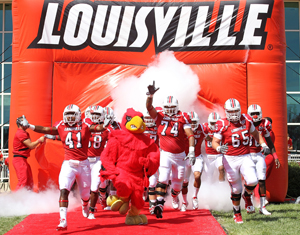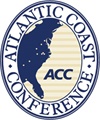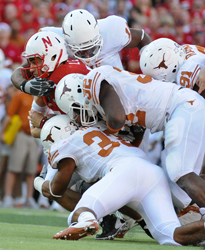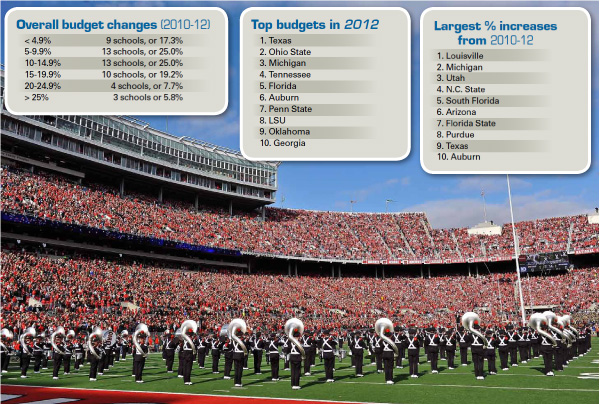Everyone in college sports is calling for cost control and lower spending, but new data shows schools spending more than ever.
A majority of schools have increased their budgets by double-digit percentages from fiscal years 2010 to 2012, according to information obtained by SportsBusiness Journal from schools in the six major conferences.
Of the 52 schools that provided annual budgets, 30 have increased their spending by 10 percent or more in the last three years. Seventeen of them, or a third, have increased spending by 15 percent or more.
In some cases, creative athletic directors have found new revenue streams that provide them more money to pump into facilities, salaries and other discretionary spends. In other cases, spending is on the rise because of mandatory costs, such as tuition increases that drive up scholarship costs and administrative fees that are paid back to campus for services like legal, police and utilities.
Administrators explain the increases by saying that they’re reinvesting in their programs and that the new revenue coming from richer TV contracts is funding the additional spending.
“When you look two to three years out, it looks like we’re falling off the edge of a cliff,” said Jamie Pollard, Iowa State’s AD. “It’s a scary thought. But the cliff keeps moving further and further away. ADs have found ways to raise new revenue, trim costs and figure it out. … A year and a half ago, we were making a lot of strategic decisions about the cost of travel, salaries, ways we could make some cuts. We’re not doing that as much this year. Our basketball team is making a trip overseas this year and that’s something we wouldn’t have done a year or two ago.”
Across the country, schools are seeing increases in revenue from a variety of areas, but the two main sources are new TV contracts and premium seating for football.
 |
GETTY IMAGES
The University of Louisville’s athletic budget has grown 31.3 percent in the past three years to $68.8 million thanks in part to a new downtown arena and premium seating in the football stadium. |
The University of Louisville’s budget has grown from $52.4 million to $68.8 million, an increase of 31.3 percent from the Cardinals’ new downtown basketball arena and premium seating in the football stadium, which has grown from a capacity of 42,000 to 55,000.
Michigan, likewise, has used new premium seating revenue from football to help drive up its budget from $84.6 million to $109.8 million, a 29.8 percent rise.
Texas, which annually has the nation’s largest budget, will see its numbers jump by $15 million this year mostly because of its new contract with ESPN to run the Longhorn Network.
In a classic case of the rich getting richer, the Longhorns’ budget will leap to a record $153.5 million this year. What’s more remarkable is that Texas has just 17 sports to support, fewer than most schools its size.
UT’s budget has grown from $129.9 million just two years ago, an 18.2 percent increase. Not only does Texas have the largest budget in the country, its budget has grown more percentage-wise since 2010 than any of its counterparts in the Big 12.
These types of double-digit increases are not expected to stop any time soon.
“I really question what kind of ROI filter they use on their expenditures,” said A.J. Maestas, president of Chicago-based Navigate Marketing. “Is that stadium expansion really necessary? Are they doing it just to keep up with their rival? But on the other hand, I don’t think the money is going to run out any time soon. I still see a decade’s worth of very aggressive growth rates, probably 10 percent or more with most schools, with more commercial expertise in tickets, donations, sponsorships, premium seating and TV revenue. The cost curve is not slowing down, but I think schools can continue to keep pace with revenue.”
 |
| ACC |
| School |
FY2010 |
FY2011 |
FY2012 |
Change (2010-12) |
| Clemson |
$57.6 |
$58.4 |
$62.5 |
+8.5% |
| Florida State |
$48.1 |
$55.0 |
$57.9 |
+20.4% |
| Georgia Tech |
$52.5 |
$55.1 |
$58.9 |
+12.2% |
| Maryland |
$52.7 |
$56.0 |
$62.1 |
+17.8% |
| North Carolina |
$61.8 |
$65.4 |
$72.2 |
+16.8% |
| N.C. State |
$45.7 |
$49.5 |
$56.6 |
+23.9% |
| Virginia |
$58.5 |
$64.7 |
$67.7 |
+15.7% |
| Virginia Tech |
$48.0 |
$50.3 |
$49.0 |
+2.1% |
| * Budgets for Boston College, Duke, Miami and Wake Forest were not available. |
| |
 |
| BIG TEN |
| School |
FY2010 |
FY2011 |
FY2012 |
Change (2010-12) |
| Illinois |
$71.1 |
$71.4 |
$70.2 |
-1.0% |
| Indiana |
$55.4 |
$58.1 |
$61.5 |
+11.0% |
| Iowa |
$65.6 |
$70.1 |
$74.9 |
+14.2% |
| Michigan |
$84.6 |
$103.9 |
$109.8 |
+29.8% |
| Michigan State |
$74.0 |
$76.1 |
$78.8 |
+7.5% |
| Minnesota |
$74.1 |
$76.7 |
$78.6 |
+6.1% |
| Nebraska |
$74.3 |
$79.4 |
$79.1 |
+6.5% |
| Ohio State |
$118.1 |
$128.4 |
$126.5 |
+7.1% |
| Penn State |
$85.5 |
$89.2 |
$92.0 |
+7.6% |
| Purdue |
$57.3 |
$57.6 |
$68.7 |
+19.9% |
| Wisconsin |
$83.3 |
$83.1 |
$88.1 |
+5.8% |
| * Budgets for Northwestern were not available. |
| |
 |
| BIG 12 |
| School |
FY2010 |
FY2011 |
FY2012 |
Change (2010-12) |
| Iowa State |
$40.1 |
$42.3 |
$47.0 |
+17.3% |
| Kansas |
$61.1 |
$64.4 |
$67.2 |
+10.0% |
| Kansas State |
$44.2 |
$47.0 |
$51.5 |
+16.5% |
| Missouri |
$50.0 |
$53.2 |
$56.4 |
+12.8% |
| Oklahoma |
$80.5 |
$85.2 |
$90.5 |
+12.4% |
| Oklahoma State |
$49.6 |
$53.7 |
$57.8 |
+16.5% |
| Texas |
$129.9 |
$136.8 |
$153.5 |
+18.2% |
| Texas A&M |
$68.8 |
$69.0 |
$75.8 |
+10.2% |
| Texas Tech |
$56.2 |
$53.0 |
$54.0 |
-3.9% |
| * Budgets for Baylor were not available. |

 |
| PAC-12 |
| School |
FY2010 |
FY2011 |
FY2012 |
Change (2010-12) |
| Arizona |
$45.0 |
$50.0 |
$55.0 |
+22.2% |
| Arizona State |
$47.3 |
$45.6 |
$48.6 |
+2.7% |
| California |
$69.4 |
$64.2 |
$71.2 |
+2.6% |
| Colorado |
$46.6 |
$47.4 |
$49.3 |
+5.8% |
| Oregon |
$77.9 |
$84.5 |
$87.8 |
+12.7% |
| Oregon State |
$49.8 |
$48.7 |
$56.6 |
+13.7% |
| UCLA |
$61.9 |
$64.1 |
$64.1 |
+3.6% |
| Utah |
$27.8 |
$29.7 |
$35.0 |
+25.9% |
| Washington |
$63.2 |
$62.1 |
$67.1 |
+6.2% |
| Washington State |
$37.0 |
$38.5 |
$39.3 |
+6.2% |
| * Budgets for Southern California and Stanford were not available. |
| |
 |
| SEC |
| School |
FY2010 |
FY2011 |
FY2012 |
Change (2010-12) |
| Alabama |
$96.2 |
$94.6 |
N/A |
N/A |
| Arkansas |
$60.3 |
$63.3 |
$69.0 |
+14.4% |
| Auburn |
$81.0 |
$88.7 |
$95.7 |
+18.1% |
| Florida |
$98.6 |
$95.4 |
$97.7 |
-1.0% |
| Georgia |
$84.8 |
$84.8 |
$90.0 |
+6.1% |
| Kentucky |
$72.7 |
$79.4 |
$83.6 |
+15.0% |
| LSU |
$81.5 |
$88.3 |
$90.6 |
+11.2% |
| Mississippi |
$42.0 |
$43.7 |
$47.6 |
+13.3% |
| Mississippi State |
$35.9 |
$37.4 |
$40.1 |
+11.7% |
| South Carolina |
$73.0 |
$77.0 |
$79.0 |
+8.2% |
| Tennessee |
$100.9 |
$100.0 |
$103.3 |
+2.4% |
| * Budgets for Vanderbilt were not available. |
| |
 |
| BIG EAST |
| School |
FY2010 |
FY2011 |
FY2012 |
Change (2010-12) |
| Connecticut |
$58.4 |
$62.0 |
$64.0 |
+9.6% |
| Louisville |
$52.4 |
$64.4 |
$68.8 |
+31.3% |
| Rutgers |
$64.2 |
$62.0 |
N/A |
N/A |
| South Florida |
$32.7 |
$37.8 |
$40.4 |
+23.5% |
| West Virginia |
$56.0 |
$58.0 |
$58.0 |
+3.6% |
N/A=Not available
Note: Projected number for Connecticut's budget, which has not yet received state approval.
Big East non-football schools excluded.
* Budgets for Cincinnati, Pittsburgh, Syracuse and TCU were not available. |
The Knight Commission, a watchdog group made up mostly of current and former college administrators, issued a report two years ago that called these budget increases unsustainable. “At many universities, spending on high-profile sports is growing at double or triple the pace of spending on academics,” the Knight Commission wrote.
But the criticism hasn’t slowed spending on many campuses.
Schools in the ACC have increased their spending the most, with an average jump of 14.6 percent among the eight public schools that supplied their budgets. The ACC’s new TV contract with ESPN, which doubled revenue to about $155 million a year, accounts for much of the increase.
Schools in the Big 12 have been the next-most aggressive, increasing their budgets 12.6 percent, followed by the Big
 |
GETTY IMAGES
The Longhorns overwhelm other schools when it comes to the size of their athletic budget. |
East at 11.2 percent. The Big Ten, SEC and Pac-12 conferences each raised spending 8 percent to 10 percent.
More increases will be on the way for Pac-12 schools once their new $250 million-a-year TV deal with ESPN and Fox takes effect in fiscal 2013.
“A lot of change in spending is related to making reinvestments in facilities, based largely on money from new TV deals,” Pollard said. “We’re going forward with three new projects and we’re taking on debt for that, but we’re doing so knowing that revenue is going up.”
While TV revenue will push budgets higher in the future, ADs also must contend with rising costs in what they call the hidden expenses, such as administrative fees that go back to campus for services such as police, accounting, legal, utilities and other mandatory charges.
North Carolina State’s administrative costs jumped from $700,000 to $1.4 million this year.
“At most places, you’re talking about at least $1 million in new mandatory expenses every year before you even look at travel, equipment and other costs,” Oregon AD Rob Mullens said.
Diane Moose, associate AD at N.C. State, said she plans for at least a 6 percent increase in utilities each year.
“People don’t think about a lot of those costs, but we’ve got to pay them,” Moose said. “You’ve got to insure buildings and you’ve got to provide health benefits, and those costs are going up.”
Conference by conference
| % INCREASE FROM 2010-12 |
|
MEDIAN BUDGET |
| ACC |
14.60% |
|
ACC |
$60.5M |
| Big 12 |
12.60% |
|
Big 12 |
$57.8M |
| Big East |
11.20% |
|
Big East |
$62.0M |
| Big Ten |
10.10% |
|
Big Ten |
$78.8M |
| Pac-12 |
9.10% |
|
Pac-12 |
$55.8M |
| SEC |
8.40% |
|
SEC |
$90.3M |
* Projections were used for schools whose 2012 budget has not yet been approved.
More mandatory expenses could fall on athletic departments if the conference commissioners follow through with their support of the “full cost of education” for each scholarship athlete. Currently, the grant-in-aid covers room, board, tuition and books, but a “full cost” measure would provide spending money for entertainment and occasional travel. Many academic scholarships already include some spending money.
Some estimate that schools might have to come up with an additional $1 million to $1.5 million to cover the full cost of education for every scholarship athlete in revenue and nonrevenue sports. Most schools in the six major conferences are studying the exact effect of this on the budget, and they’re counting on conference TV revenue to shoulder the cost.
The bigger-ticket items are salaries and scholarships, which account for close to half of the expenses in an athletic department. For schools such as Indiana and Oregon, that recruit most of their scholarship athletes from out of state, the scholarship fee jumps significantly to pay that out-of-state tuition.
Indiana, for example, brings 70 percent to 75 percent of its athletes in from outside the state. At Oregon, it’s 80 percent.
“When tuition jumps up, like it has a lot in recent years, we have to pay that full bill,” said Kevin Clark, Indiana’s associate AD. “We receive no waivers for out-of-state students.”
Salaries are a huge chunk for most budgets, as much as 40 percent of the overall budget in some cases. At Tennessee, for example, the Volunteers still have another year to pay former football coach Phillip Fulmer his $1.5 million-a-year buyout. Much of Arkansas’ 9 percent budget hike this year was tied to an increase in salary for football coach Bobby Petrino and the hiring of basketball coach Mike Anderson.
The new revenue from TV also has administrators thinking more about increasing their reserve funds. Athletic departments typically try to keep 10 percent of their annual budget locked away in the bank for a rainy day.
“Budgets aren’t quite as tight as they were a couple of years ago, but we’re still watching everything closely,” N.C. State’s Moose said. “Most every school is dealing with state budgets that are getting worse and you’ve got to be prepared to do more with less. I’ve never seen a campus come in and take cash reserves from athletics — I’ve never felt that threat — but that doesn’t mean it couldn’t happen.”

GETTY IMAGES
Ohio State’s $126.5 million athletic budget is the second-largest in college sports.










